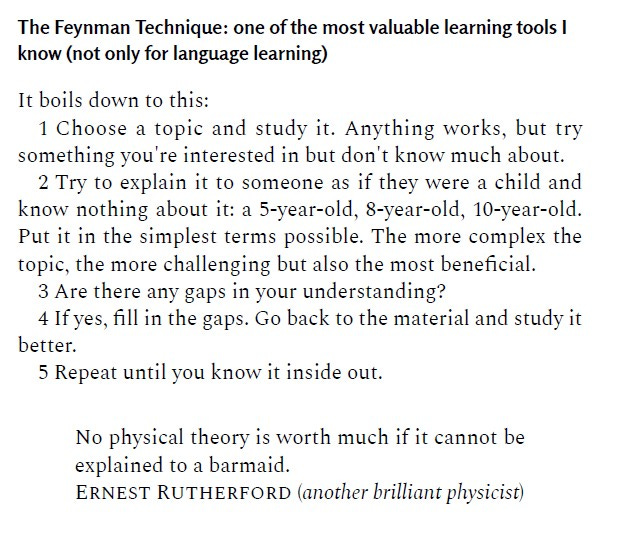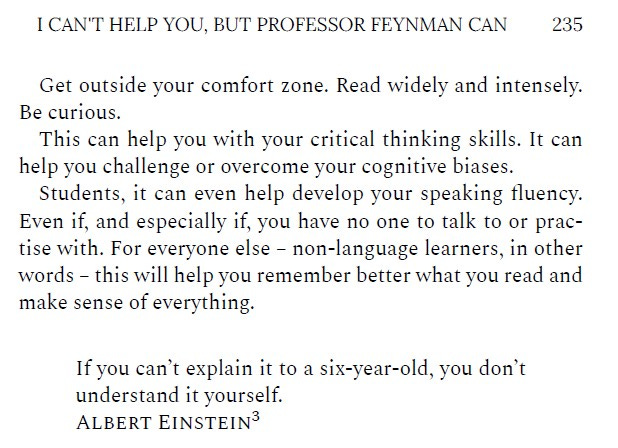Never mind a teacher – YOU be the teacher
Boost your brain by explaining complex topics to a rubber duck or cuddly toy
Three things have inspired me to write this post.
For language learners, we’ll talk concretely about how you can practise your fluency.
For learners, non-learners, or laypeople – if I may use this word – we’ll talk about the Feynman Technique and the protégé effect for improving your understanding of complex ideas. I’ll also demonstrate by talking to a cuddly lobster.
And guess what – you don’t even have to read anything to do these. You can, and I recommend it, but if you truly despise reading – though I doubt that because you are here, after all – then there’s a less strenuous way. BUT…BUT (!)…reading about a complex topic, as I’ll demonstrate, will do wonders for your brain cells.
I’m saying this for me and for you
Before we proceed, I’ll share some thoughts. I started this Substack well over a year ago with my goal being to reach out to language learners. Roughly half my readers are former students or colleagues, with the other half being a mixture of family members I can’t seem to shake, friends, groupies, riffraff, hangers-on, and a lovely bunch of Substack writers, 95% of which are much better than mine.
This presents me with a healthy challenge: diversifying my writing while staying true to my original goals. I always appreciate feedback to let me know how I’m doing, and I also realise, as many of you who read other newsletters do, that not every post will appeal to everyone. That’s fine. I’ve already mentioned the value in skimming and our time is finite - only 4,000 weeks, on average. How does that make you feel?
The one thing I do not want to write, which was the goal with my book, was a dull grammar and vocabulary reference book. There are way too many of those - they are a dime a dozen.
Some of my favourite book feedback has come from the laypeople who enjoyed the language advice sections. I don’t want to embarrass one friend, a native speaker of English, but she told me the vocabulary-related advice was incredibly beneficial, while some of my language learning audience told me they skipped over some of that material in favour of the salacious stories (though none of them used the word salacious, thus proving that they shouldn’t be skipping those sections – as I tell people all the time, don’t be complacent! That goes for language learning, being in a relationship, professionally, whatever.)
Also proving popular were the inside-the-classroom secrets and stories, including me telling an obnoxiously annoying student to “chill the fuck out!” (which prompted her to walk out of the room and the rest of the class to applaud).
That said, this advice is very much for everyone. It’s a follow up to my previous post, based on a couple of requests for further examples and to put more of what I preach into practice. That was the first inspiration.
(The things I put in bold, as a reminder (to some), are mostly for language learners; they are also to highlight key concepts.)
Other inspirations
1 I often chat with a father from my daughter’s dance class. His English isn’t great and it’s a struggle for him to get his message across, but the poor guy is trying his best, even if causes me strain to listen. And before you think I’m being terribly harsh here – although I am an asshole much of the time (sorry) – in many speaking exams, one of the criterion is ‘doesn’t put the listener under undue strain.’ Believe me, my ears were crying out in pain, but that’s not necessarily his fault.
A good language learner can improve their fluency on their own with lots of practice, practice and practice, through paraphrasing. You do not need a teacher to help you with this.
With very few exceptions, most language learners I’ve met need practice with fluency – specifically, their speaking pace, paraphrasing and elaborating. It’s not about being accurate – there are other times and places for working on that (and that’s harder to do without a teacher, in all honesty). It’s about being able to say what you want, at length, without doing it tooooo sl…ow…ly…
Unfortunately, this guy didn’t know how to paraphrase. He was mixing up Ukrainian, German and English as well.
You can start by paraphrasing, and then fill in the gaps with the words you didn’t know, repeating it again to use new vocabulary.
2 This note from The Healing Abode caught my eye:
Take heed of this advice. “Tell your story without worry.” Beautiful.
My response:
I’ve heard from a couple of writers using this platform to improve their writing skills in English, and people like this are awe-inspiring. If only I could get my students to do more of this…
Which is why I’m going to present everyone with a fun writing challenge in my next post.
3 Returning to that third piece of inspiration:
Many of you have no doubt heard of the Feynman Technique. In my book – another shameless plug, and stay tuned for a super duper special offer below – I dedicated some 3-4 chapters to this, along with further explanations on using variations of it to practice speaking skills and activate vocabulary. This is one of my favourite sources for reading up on it: The Feynman Technique, Farnam St
Let me cheat here and share with you a few literal snippets from my book. Pay attention in particular to the wise words of Richard Feynman, Ernest Rutherford and Albert Einstein:
You might also have heard of the protégé effect, similar to the Feynman Technique. In effect it’s learning by teaching. Do you think I knew a damn thing about teaching English before I started nearly twenty years ago? Hell no – I was making the shit up as I went along, I was clueless. But eventually I got there and became a painfully mediocre teacher (I got the job done, put it that way).
This Guardian article explains why this concept is so powerful due to the “brain boost” it provides, backed up by solid research. A short excerpt:
“The brain boost appears to arise as much from the expectation of teaching as the act itself. If we know that others are going to learn from us, we feel a sense of responsibility to provide the right information, so we make a greater effort to fill in the gaps in our understanding and correct any mistaken assumptions before we pass those errors on to others. Articulating our knowledge then helps to cement what we have learned.”
“We can see the protege effect in students’ brains, with greater activity in regions responsible for attention, working memory and taking others’ perspectives. Across the brain, our neurons appear to be processing the material more deeply, which results in longer-lasting memories.”
There, that’s your proof. I could’ve summarised but who am I to give you irrefutable scientific evidence? Trust the experts – not me.
Both of these techniques can be done on your own. Have you ever heard of rubber duck debugging? This is something programmers use to explain complex code. Explaining intricate ideas out loud is a good way of seeing if your ideas are clear and understandable, without any potential stumbling blocks. Writers also do this when writing dialogues to see whether it sounds natural.
This is how it works, for anyone (it doesn’t have to be limited to programmers):
1 Find a rubber deck. This is easier if you have kids. I prefer using a cuddly toy.
2 Tell the duck you’re going to explain something tricky. Pretend the duck understands you.
3 Break the issue down and go into as much detail as necessary.
4 Ask the duck if there are any questions. It probably won’t answer you, but you can anticipate potential questions or problems.
These two techniques use the same general principles, and if your goal is to practice fluency, you can leave out a lot of details, for which the Feynman Technique is more suitable. If your goal is to master the concept and demonstrate a clear and thorough understanding, then you will need to go more in-depth with either technique.
Let’s demonstrate. You can now listen to me attempt to use bits of both techniques to my six-year-old daughter.
As a bonus, I will try to explain commodity prices to Larry the Lobster, and cognitive biases to everyone else, in a separate post.
What I am trying to explain first
1 Football, or soccer if you prefer, different formations: the 4-4-2, 4-3-3, the classic Scottish 5-5-0 and the American youth 0-0-10 or 1-1-1-1-1-1-1-1-1-1. (IYKYK)
2 My daughter loves the Technology Museum in Vienna and she’s 6, so I need to be able to explain this stuff to her, according to Einstein. But it’s hard since I hardly understand much of this myself. I’ve chosen something topical and relevant for her interests and worldly knowledge, which consists heavily of Katy Perry and Disney cartoons.
As you’ll hear in the audio, if you’re merely trying to process it for your own understanding, that’s a more achievable feat. If you want to make your listener really get a grasp of the concept, then your choice of topic and the listener’s background knowledge will make a difference.
Here’s me at the museum where I feel very old:
Language learners - did you know about this?
Probably not, because I didn’t email it or inform you. Those who have read it have either done so because you’ve explored my site, or were directed here from chapter 6 of my book.
In Learning resources, you’ll find two posts, with more to come in due course:
1 Grade the task, not the text: authentic materials. I’ve taken two texts and analysed how to guess meaning from context.
2 Using the Feynman Technique and the protégé effect to talk to a lobster
In my next post, on Wednesday (30 Oct), I will share my November writing challenge plan and also invite people to collaborate with me - especially language learners.
Want to support me?
Now you can leave me a small tip, if you so choose, with an added incentive.
There’s been a bit of chatter lately on Substack about paywalls and ‘buy me a coffee’ links and the idea of monthly/yearly subscriptions versus paying per post. Well, how about this as a bonus (because some of you have said you want to support me, for some absurd reason, but thank you all the same).
My book can be found here if you want to buy it from any worldwide retailer: Daniel’s damn book. It’s $4.99 and the equivalent in other currencies, for example euros, pounds, rupees, yen, salt, plundered statues, Roman coins, etc.
You can also buy it direct from me: Daniel’s world-class website with all sorts of bells and whistles. It’s pricier there: a whopping $9.99. “To hell with that,” you’re thinking.
But wait! How about this: you can now get it, for one week only, plus or minus a month, for however much you want! All you need to do is enter any of the following discount codes for how much you want to contribute to my beer and coffee fund (which sustains my creativity and gives me something to look forward to in my pitiful existence).
Want to pay $2? Enter the code TWOBUCKS
$3? THREEBUCKS
$4? FOURBUCKS
$5? FIVEBUCKS
$100? I’MANIDIOT
Buying direct means you get the EPUB and the PDF and you know what else? You can share that PDF with a friend, colleague or someone you dislike as a punishment. I’m happy for you to spread the joy/pain.
The book is 340 pages, 1/3 of which is absolutely brilliant, Nobel Prize level material; 1/3 painfully average; and 1/3 dire drivel. You’ll have to find out for yourselves. There’s even an excruciatingly turgid 10,000 word autobiography if you want to learn a bit about my background and how I ended up in Ukraine. My favourite parts to write were the ones where I insult my students and whinge about my workplace, and there’s some occasional swearing here and there, but nothing too egregious.












Daniel- This article really reminds me of the curious times I’ve explained something to someone, and through that exercise of explaining, I became all the more educated myself. I appreciate the insight here.
Always such a fun read Daniel! I really like that Einstein quote and the rubber duck technique. When is your range of branded ducks /lobsters coming out?! Seriously though, I can see how this would work and is so simple - and necessary - because simply by writing something down, I find that I'm already so familiar with it, others must be too. I you don't question that, at some point, you'll always just assume, which is when you make an 'ass' of yourself or whatever that quote says.